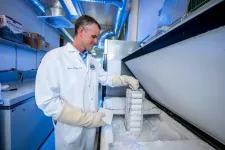(Press-News.org) Over half of the UK's arts and cultural venues and organisations believe they are at risk due to the decline in income during the pandemic, a new study from the University of Sheffield, University of Kent, and the Chartered Institute of Fundraising has shown.
The only study of its kind, 'Dealing with the crisis: Creativity and resilience of arts and cultural fundraisers during Covid-19' (28 May 2021), gathered information about how arts and cultural fundraisers were impacted by, and managed the Covid-19 pandemic during 2020.
Many artists, organisations and venues rely on fundraising as a significant part of their income, using a range of events and activities to fund creative projects, alongside raising funds through patrons, donations, memberships and subscriptions.
The study has highlighted a number of risks which threaten to harm the diversity and richness of the sector due to the impact of the pandemic.
Almost two thirds of fundraisers (62 per cent) surveyed in the study, expected their organisation's income to fall during the pandemic, with nearly half (47 per cent) reporting the social restrictions during the pandemic meant many of their revenue generating programmes had been postponed.
Some key findings of the report included:
79 per cent of respondents said that their fundraising activity overall has decreased
66 per cent of organisations said they had postponed planned arts and cultural projects and programmes
64 per cent said financial support in 2021 and beyond was very important to the survival of the sector
89 per cent said supporting organisations unable to access emergency funding was important
Reports of increased workload and stress also highlighted the concern that if staff welfare issues are not addressed, there will be a real risk of a significant loss of talent from the sector in the future.
Dr Marta Herrero, from the University of Sheffield's Management School, led the study. She said: "The social restrictions in place during most of the pandemic made a lot of normal fundraising activities impossible for a wide variety of arts and cultural organisations.
"Closures of venues and cancelled events left a gaping hole in the finances of many in the sector, with fundraisers having to quickly find new and flexible ways to raise money in an accessible way to ensure the survival of their organisation."
The research did however, find examples of arts and cultural fundraisers adapting and responding to new ways of working, taking new approaches and changing their fundraising activities during the pandemic. A total of 55 per cent of fundraisers said new approaches to digital offers for members and supporters had met, or exceeded their expectations; with many commenting on having the digital infrastructure to hold events and programmes online meant they were able to broaden their audiences.
The authors of the study are now calling on the government to provide substantial support, in the hope that the findings will be able to inform policy on how best to allocate financial resources; as some smaller or independent organisations are falling between the gaps of emergency support available.
Dr Herrero, said: "So many of us interact with and benefit from arts, cultural and heritage organisations regularly, such as museums, live music venues, visiting sites of historical interest, or even attending events and activities run by community groups.
"But a significant number of fundraisers report that the sector needs continued financial support, and for furlough and recovery fund schemes to be accessible for all to ensure its survival in the medium and long term.
"Whilst resilience and innovation continue to be key skills characteristic of the fundraising profession in the face of prolonged funding cuts, only with this kind of support will they be able to safeguard the richness of our cultural life here in the UK and create a sustainable sector akin to pre-Covid levels."
Martin Kaufman, Chair of the Chartered Institute of Fundraising RAISE Steering Committee said: "This survey is the first time that the collective voice of UK cultural fundraisers has been heard during the pandemic.
"There are important lessons to be learnt from what the respondents have told us. These need to be taken up by the government and everyone who wants fundraising for arts and heritage to play a critical role in ensuring that cultural activity itself will not just recover but thrive into the future. This survey was conducted in 2020, but what it has to tell us is still of continuing and significant relevance."
INFORMATION:
Media contact: Rebecca Ferguson, Media Relations Officer, 0114 222 3607, r.l.ferguson@sheffield.ac.uk
Notes to editors:
'Dealing with the crisis' project was initiated in April 2020 by the Chartered Institute of Fundraising through its RAISE Steering Committee (funded by Arts Council England) and Cultural Sector Network in collaboration with a team from the Universities of Sheffield and Kent led by Dr Marta Herrero from the University of Sheffield's Management School."
For an embargoed copy of the report, please contact the Media Relations Officer.
The University of Sheffield
With almost 29,000 of the brightest students from over 140 countries, learning alongside over 1,200 of the best academics from across the globe, the University of Sheffield is one of the world's leading universities.
A member of the UK's prestigious Russell Group of leading research-led institutions, Sheffield offers world-class teaching and research excellence across a wide range of disciplines.
Unified by the power of discovery and understanding, staff and students at the university are committed to finding new ways to transform the world we live in.
Sheffield is the only university to feature in The Sunday Times 100 Best Not-For-Profit Organisations to Work For 2018 and for the last eight years has been ranked in the top five UK universities for Student Satisfaction by Times Higher Education.
Sheffield has six Nobel Prize winners among former staff and students and its alumni go on to hold positions of great responsibility and influence all over the world, making significant contributions in their chosen fields.
Global research partners and clients include Boeing, Rolls-Royce, Unilever, AstraZeneca, GlaxoSmithKline, Siemens and Airbus, as well as many UK and overseas government agencies and charitable foundations.
International research led by Monash University and the Peter Doherty Institute for Infection and Immunity has achieved a proof of concept for a new, fast, portable saliva screening test that uses an infrared light technology to confirm infection with SARS-CoV-2.
The research is published today in Angewandte Chemie.
Professor Bayden Wood, from the Monash University School of Chemistry, Dr Phil Heraud formerly from the Monash Biomedicine Discovery Institute and collaborators Professors Dale Godfrey and Damian Purcell from the Doherty Institute, report on a new diagnostic approach, which involves the use of a portable infrared instrument to detect the SARS-CoV-2 virus ...
On scales too small for our eyes to see, the business of life happens through the making of proteins, which impart to our cells both structure and function. Cellular proteins get their marching orders from genetic instructions encoded in DNA, whose sequences are first copied and made into RNA in a multi-step process called transcription.
A research collaboration at Colorado State University specializes in high-resolution fluorescence microscopy and computational modeling to visualize and describe such stuff-of-life processes in exquisite detail, ...
SAN ANTONIO (May 27, 2021) -- One-fifth of babies who inherit a genetic variant located on chromosome 16 will develop autism spectrum disorder (ASD) by age 3. The variant is called 16p11.2 deletion.
Noboru Hiroi, PhD, of The University of Texas Health Science Center at San Antonio (also referred to as UT Health San Antonio), is studying mice that have this deletion. The team, which includes colleagues from Japan, Ireland and the U.S., is harnessing the power of machine learning to understand which vocalizations of the newborn mouse pups are most predictive of social abnormalities one month ...
Nobody likes driving in a blizzard, including autonomous vehicles. To make self-driving cars safer on snowy roads, engineers look at the problem from the car's point of view.
A major challenge for fully autonomous vehicles is navigating bad weather. Snow especially confounds crucial sensor data that helps a vehicle gauge depth, find obstacles and keep on the correct side of the yellow line, assuming it is visible. Averaging more than 200 inches of snow every winter, Michigan's Keweenaw Peninsula is the perfect place to push autonomous vehicle tech to its limits. In two papers presented at SPIE Defense + Commercial Sensing 2021, researchers from Michigan Technological University discuss solutions for snowy driving scenarios that ...
Ionizing radiation is used for treating nearly half of all cancer patients. Radiotherapy works by damaging the DNA of cancer cells, and cells sustaining so much DNA damage that they cannot sufficiently repair it will soon cease to replicate and die. It's an effective strategy overall, and radiotherapy is a common frontline cancer treatment option. Unfortunately, many cancers have subsets of cells that are able to survive initial radiotherapeutic regimens by developing mechanisms that are able to repair the DNA damage. This often results in resistance to further radiation as cancerous growth recurs. But until recently, little was known about exactly what happens in the genomes of cancer cells following radiotherapy.
To probe the traits of post-radiotherapy cancer ...
May 27, 2021 - Patients undergoing total hip arthroplasty (THA) show significant reduction in pain and other symptoms and improvement in walking gait biomechanics. However, those improvements do not lead to increased daily physical activity levels, reports a study in The Journal of Bone & Joint Surgery. The journal is published in the Lippincott portfolio in partnership with Wolters Kluwer.
The findings "present a worrying picture that while patients have the opportunity to be more physically active through improvements in functional capacity, their physical behaviors do not change," according to the new research, led by Jasvir S. Bahl of the University of South Australia, Adelaide, in collaboration with the University of Adelaide, Flinders University, ...
In 29 new scientific papers, the Dark Energy Survey examines the largest-ever maps of galaxy distribution and shapes, extending more than 7 billion light-years across the Universe. The extraordinarily precise analysis, which includes data from the survey's first three years, contributes to the most powerful test of the current best model of the Universe, the standard cosmological model. However, hints remain from earlier DES data and other experiments that matter in the Universe today is a few percent less clumpy than predicted.
New results from the Dark Energy Survey (DES) use the largest-ever sample ...
LA JOLLA, CA--Even before the COVID-19 pandemic, most people in the United States already had been sick with a coronavirus, albeit a far less dangerous one. That's because at least four coronaviruses in the same general family as SARS-CoV-2 cause the benign yet annoying illness known as the common cold.
In a new study that appears in Nature Communications, scientists from Scripps Research investigated how the immune system's previous exposure to cold-causing coronaviruses impact immune response to COVID-19. In doing so, they discovered one cross-reactive coronavirus antibody that's triggered during a COVID-19 infection.
The findings will help in the pursuit of a vaccine or antibody ...
Although it is not spread through human contact, Francisella tularensis is one of the most infectious pathogenic bacteria known to science--so virulent, in fact, that it is considered a serious potential bioterrorist threat. It is thought that humans can contract respiratory tularemia, or rabbit fever--a rare and deadly disease--by inhaling as few as 10 airborne organisms.
Northern Arizona University professor David Wagner, director of the Pathogen and Microbiome Institute's (PMI) Biodefense and Disease Ecology Center, began a three-year project in 2018 to better understand the life cycle and behavior of F. tularensis, ...
An estimated one in seven Ohio women of adult, reproductive age has visited a crisis pregnancy center, a new study has found.
In a survey of 2,529 women, almost 14% said they'd ever attended a center. The prevalence was more than twice as high among Black women and 1.6 times as high among those in the lowest socioeconomic group, found a research team from The Ohio State University. Their study appears in the journal Contraception.
Crisis pregnancy centers are often supported by religious organizations and are designed to discourage women with unintended pregnancies from choosing abortion, though they don't typically advertise themselves as anti-abortion. In Ohio, where more than 100 centers are spread throughout the state, they are funded by state dollars. In 2019, during ...



